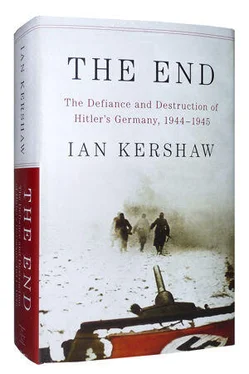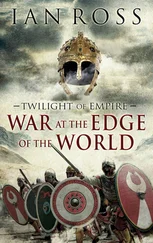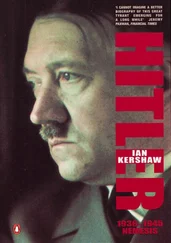101. StAA, Kreisleitung Augsburg-Stadt, 1/8, fos. 300554–5, Rundspruch an alle Kreisleiter, 30.3.45. Every Gau was to produce 100 ‘volunteers’, and Wahl laid down—on what criteria it is not clear—the contingents from each district in his region. He criticized the Kreisleiter in mid-April for doing too little to gain recruits.—Gotto, p. 375.
102. Perry Biddiscombe, Werwolf! The History of the National Socialist Guerrilla Movement 1944–1946 , Toronto and Buffalo, NY, 1998, pp. 12–14 (where the derivation of the name is discussed).
103. Biddiscombe, pp. 38, 128, 134–9.
104. TBJG , II/15, pp. 630 (30.3.45), 647 (31.3.45). For Ley’s extreme radicalism in advocating a fight to the last, see Ronald Smelser, Robert Ley: Hitler’s Labor Front Leader , Oxford, New York and Hamburg, 1988, pp. 291–2.
105. Biddiscombe, pp. 266–8; Henke, pp. 837–45.
106. Biddiscombe, p. 276, and ch. 5 for many instances of minor, uncoordinated and sporadic resistance to the Allied occupiers by former Hitler Youth members, former SS men and other Nazi diehards that punctuated the late spring and summer of 1945 and beyond, though they were only tangentially related to the Werwolf groups that had been established in the last weeks of the war.
107. Biddiscombe, p. 282, uses Allied assessments to suggest that 10–15 per cent of Germans supported the partisan movement, though this probably conflates general backing for continued resistance to the Allies and support for the regime with specific support for Werwolf activities. See Henke, pp. 948–9, for a more dismissive appraisal of support.
108. TBJG , II/15, pp. 422, 424 (5.3.45). Hitler had also thought the Mosel could be defended.— TBJG , II/15, p. 533 (18.3.45).
109. As suggested by Bernd Wegner, ‘Hitler, der Zweite Weltkrieg und die Choreographie des Untergangs’, Geschichte und Gesellschaft , 26 (2000), pp. 493–518; also in DRZW , 8, pp. 1192–1209.
110. TBJG , II/15, p. 479 (12.3.45).
111. Hitler: Reden und Proklamationen 1932–1945 , ed. Max Domarus, Wiesbaden, 1973, p. 2212.
112. TBJG , II/15, pp. 422–3 (5.3.45).
113. TBJG , II/15, p. 425 (5.3.45). For Goebbels’ fantasies of heroism as the end approached and his wife’s reluctant determination to stay in Berlin and accept not only her own death, but that of her children, see Ralf Georg Reuth, Goebbels , Munich and Zurich, 1990, pp. 587–8. Magda had apparently accepted both the certainty of Germany’s defeat and that death ‘by our own hand, not the enemy’s’ was the only choice left.—David Irving, Goebbels: Mastermind of the Third Reich , London, 1996, p. 506 (though based on recollections, reproduced in an article on Magda in a periodical in 1952 (Irving, p. 564 n. 9), of her sister-in-law Eleanor (Ello) Quandt, whose testimony as Irving acknowledges (p. 564 n. 19) was not always reliable).
114. TBJG , II/15, pp. 426–7 (5.3.45), 525 (17.3.45), 532–3 (18.3.45); and see Michael Bloch, Ribbentrop , pb. edn., London, 1994, p. 422; Reimer Hansen, ‘Ribbentrops Friedensfühler im Frühjahr 1945’, Geschichte in Wissenschaft und Unterricht , 18 (1967), pp. 716–30; and Hansjakob Stehle, ‘Deutsche Friedensfühler bei den Westmächten im Februar/März 1945’, VfZ , 30 (1982), pp. 538–55; Gerhard L. Weinberg, A World at Arms: A Global History of World War II , Cambridge, 1994, pp. 783–4.
115. IfZ, ZS 1953, ‘Iden des März. Ein zeitgeschichtliches Fragment über den letzten Kontaktversuch Ribbentrops mit Moskau in der Zeit vom 11.–16. März 1945’, fos. 1–13 (no date, probably early 1950s). For a description of Mme Kollontay, ‘the grand old lady of Soviet diplomacy’, and for Ribbentrop’s vain attempts to instigate some form of negotiated peace with the Soviet Union in early 1945, see Ingeborg Fleischhauer, Die Chance des Sonderfriedens: Deutsch-sowjetische Geheimgespräche 1941–1945 , Berlin, 1986, pp. 58–61, 268–75.
116. TBJG , II/15, pp. 450–51 (8.3.45).
117. BA/MA, RH21/3/420, fos. 34, 40, post-war account (1950) by Colonel-General Erhard Raus (former Commander-in-Chief of the 3rd Panzer Army in East Prussia, who had taken command in Pomerania of remaining forces of the 11th SS-Panzer Army) of his meetings with Himmler on 13.2.45 and 7.3.45, and his report to Hitler on 8.3.45.
118. Guderian, p. 426.
119. The above paragraph is based on: Folke Bernadotte, The Fall of the Curtain , London, 1945, pp. 19–47; Walter Schellenberg, Schellenberg , pb. edn., London, 1965, pp. 171–5; Felix Kersten, The Kersten Memoirs 1940–1945 , London, 1956, pp. 271–83; Peter Padfield, Himmler: Reichsführer-SS , London, 1990, pp. 565–6, 578–9; and Peter Longerich, Heinrich Himmler: Biographie , Munich, 2008, pp. 742–8, 967–8 nn. 131–2. In a post-war interrogation, Schellenberg—who was keen to assert both his own importance and his attempts to influence a negotiated settlement—claimed that in December 1944, in the Reichführer’s presence, he even touched on the possibility of the elimination of Hitler.—IWM, FO645/161, interrogation 13.11.45, p. 15 (1945–6).
120. DZW , 6, p. 152.
121. John Toland, The Last 100 Days , London, 1965, pp. 73, 238–44, 478–81; Padfield, pp. 573–8; Weinberg, p. 818; Peter R. Black, Ernst Kaltenbrunner: Ideological Soldier of the Third Reich , Princeton, 1984, pp. 242–5; BA/MA, N574/19, NL Vietinghoff, ‘Kriegsende in Italien’, fos. 41–6.
122. For interesting speculation on Speer’s power ambitions at this juncture, see DRZW , 10/2 (Müller), pp. 74–84; and Müller’s remarks in the conclusion to the volume, p. 718.
123. Albert Speer, Erinnerungen , Frankfurt am Main and Berlin, 1969, p. 442.
124. He had engineered Hitler’s approval to his new responsibilities on 14 February, exploiting the illness of the Transport Minister Julius Heinrich Dorpmüller.— DRZW , 10/2 (Müller), p. 82.
125. BAB, R3/1623a, fos. 18–23, Aktennotiz Speer, 7.3.45. That very day, Paul Pleiger, head of the Reich Association of Coal, pointed out to Speer how serious the coal situation was following the loss of Upper Silesia, the transport problems that had effectively ruled out Ruhr coal, and the big drop in production from the Saarland. Unless things improved, he pointed out, it would be impossible to provide coal for armaments or avoid the collapse of transport, electricity and gas.—IWM, F.3, M.I. 14/163, Pleiger to Speer, 7.3.45. On 14 March Hitler ordered that because of severely reduced transport capacity, priorities in areas to be evacuated had to be determined by their value for the prosecution of the war: the Wehrmacht, coal, then food materials. Refugees could be accommodated only where there was available space. In passing on the order next day to relevant authorities, Speer pointed out that it was on his suggestion.—BAB, R3/1623a, fos. 27–8.
126. TBJG , II/15, pp. 579 (23.3.45), 603 (27.3.45).
127. TBJG , II/15, pp. 500–501 (14.3.45), 511–12 (15.3.45).
128. BAB, R3/1623a, fos. 31–8, OKH, Chef Transportwesens/General der Pioniere und Festungen, draft, no precise date in March given; Speer to Gen.stab des Heeres-General der Pioniere und Festungen, 15.3.45; OKH, Chef Transportwesens/Gend di Pi u Fest, 14.3.45; Speer, p. 442; Guderian, pp. 422–3.
129. BAB, R3/1536, fos. 3–12; IMT , vol. 41, pp. 420–25. Drafts (fos. 28–30) were appended of orders limiting destruction and giving Speer the powers to decide on exceptions to immobilization; Speer, pp. 442–3.
130. See Heinrich Schwendemann, ‘ “Drastic Measures to Defend the Reich at the Oder and the Rhine…”: A Forgotten Memorandum of Albert Speer of 18 March 1945’, Journal of Contemporary History , 38 (2003), pp. 597–614; also Heinrich Schwendemann, ‘ “Verbrannte Erde”? Hitlers “Nero-Befehl” vom 19. März 1945’, in Kriegsende Deutschland , p. 163; and, for a different interpretation, DRZW , 10/2 (Müller), pp. 86–8. An extract from the memorandum was already published by Gregor Janssen, Das Ministerium Speer: Deutschlands Rüstung im Krieg , Berlin, Frankfurt am Main and Vienna, 1968, p. 311, though without commentary, beyond pointing (p. 310) to its connection with Keitel’s order that morning to evacuate the population from the fighting zone west of the Rhine. Dietrich Eichholtz, Geschichte der deutschen Kriegswirtschaft 1939–1945 , vol. 3: 1943–1945 , Berlin, 1996, p. 662 n. 212, confines himself to the comment that Speer had ‘doubtless tactical aims’ with the memorandum. Neither Gitta Sereny, Albert Speer: His Battle with Truth , London, 1995, pp. 476–7, nor Joachim Fest, Speer: Eine Biographie , Berlin, 1999, pp. 336–8, mentions it.
Читать дальше












